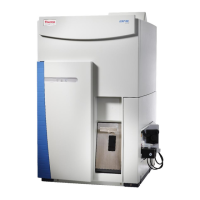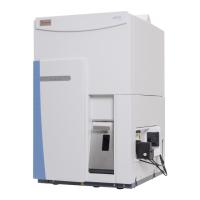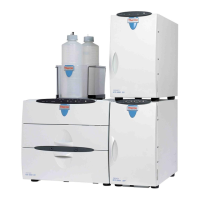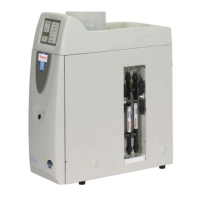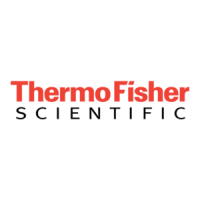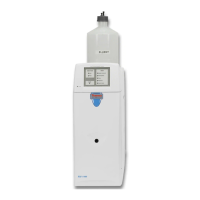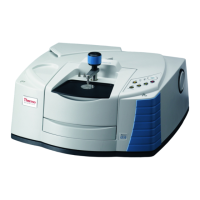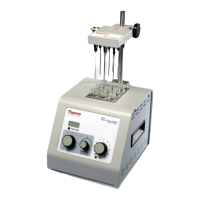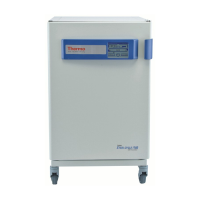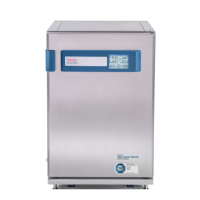Do you have a question about the Thermo Scientific iCAP Q and is the answer not in the manual?
Provides an overview of the manual's content, including precautionary statements and instrument descriptions.
Details text formatting, signal words, and notation conventions used throughout the manual.
Explains the heading structure used to organize topics within chapters.
Lists additional reference documents and resources for the iCAP Q mass spectrometer.
Lists the standard components included with the iCAP Q system.
Lists frequently shipped optional components for the iCAP Q MS system.
Overview of the iCAP Q mass spectrometer's design and models.
Details the four main components of the iCAP Q instrument.
Describes the components of the sample introduction system, including pump and nebulizer.
Explains the ion optics region, including RAPID lens and QCell.
Details the quadrupole mass analyzer and detector components.
Describes the three-stage pumping system for the iCAP Q instrument.
Covers argon and other gas requirements for operating the iCAP Q.
Specifies requirements for the cooling water used by the iCAP Q.
Details the exhaust ports and system requirements for the iCAP Q.
Illustrates the various connection points on the iCAP Q instrument.
Explains safety symbols, signal words, and their meanings in the manual.
Lists and describes safety labels found on the iCAP Q instrument.
Details the system information found on the instrument's rating plate.
Defines the proper usage and limitations of the iCAP Q mass spectrometer.
Specifies requirements for personnel and materials for iCAP Q installation and operation.
Outlines essential safety measures related to electrical hazards.
Highlights potential residual hazards and necessary precautions during operation.
Provides recommendations for eye protection, clothing, and gloves.
Details electromagnetic compatibility information and usage guidelines.
Explains steps to shut off the plasma or the entire system in an emergency.
General safety guidelines to follow during the installation of the iCAP Q.
Guidelines and dimensions for positioning the iCAP Q instrument.
Specifies requirements for power supply, temperature, and humidity.
Key safety precautions to observe while operating the iCAP Q system.
Details the instrument's front panel controls and status indicator lights.
Procedure for safely starting the iCAP Q instrument.
Instructions for switching to standby or completely shutting down the system.
Steps to prepare the iCAP Q for analysis, including performance checks.
Guidance on loading, submitting, and working with LabBooks for data evaluation.
Recommended procedures after completing experiments, like flushing and cleaning.
General advice, rules, and safety precautions for diagnosing and solving instrument problems.
Lists common error messages and their corresponding causes and remedies.
Step-by-step guide to resolve issues with the plasma not igniting.
Guidance for resolving issues related to low or no signal output.
Procedures to address and correct signal drift issues.
Steps to diagnose and improve poor signal stability.
Explanation of instrument interlocks and how to reset them.
Essential safety precautions to follow during maintenance tasks.
Provides general recommendations and rules for performing maintenance.
Lists routine and infrequent maintenance procedures with their frequency.
Covers cleaning surfaces, agents, and checking warning labels.
Instructions for checking and cleaning the instrument's air filter.
Procedures for maintaining the nebulizer, pump, and spray chamber.
Guidance on cleaning and replacing sample/skimmer cones and extraction lens.
Information on maintenance tasks performed by Thermo Fisher Scientific personnel.
Safety precautions specific to the fore vacuum pump.
Safety warnings and precautions for the recirculating chiller unit.
Safety guidelines and warnings related to the Dionex ICS-5000 system.
Statement regarding the device's compliance with FCC rules.
Information on compliance with the Waste Electrical and Electronic Equipment Directive.
Manufacturer's declaration of conformity with relevant EC directives.
Provides an overview of the manual's content, including precautionary statements and instrument descriptions.
Details text formatting, signal words, and notation conventions used throughout the manual.
Explains the heading structure used to organize topics within chapters.
Lists additional reference documents and resources for the iCAP Q mass spectrometer.
Lists the standard components included with the iCAP Q system.
Lists frequently shipped optional components for the iCAP Q MS system.
Overview of the iCAP Q mass spectrometer's design and models.
Details the four main components of the iCAP Q instrument.
Describes the components of the sample introduction system, including pump and nebulizer.
Explains the ion optics region, including RAPID lens and QCell.
Details the quadrupole mass analyzer and detector components.
Describes the three-stage pumping system for the iCAP Q instrument.
Covers argon and other gas requirements for operating the iCAP Q.
Specifies requirements for the cooling water used by the iCAP Q.
Details the exhaust ports and system requirements for the iCAP Q.
Illustrates the various connection points on the iCAP Q instrument.
Explains safety symbols, signal words, and their meanings in the manual.
Lists and describes safety labels found on the iCAP Q instrument.
Details the system information found on the instrument's rating plate.
Defines the proper usage and limitations of the iCAP Q mass spectrometer.
Specifies requirements for personnel and materials for iCAP Q installation and operation.
Outlines essential safety measures related to electrical hazards.
Highlights potential residual hazards and necessary precautions during operation.
Provides recommendations for eye protection, clothing, and gloves.
Details electromagnetic compatibility information and usage guidelines.
Explains steps to shut off the plasma or the entire system in an emergency.
General safety guidelines to follow during the installation of the iCAP Q.
Guidelines and dimensions for positioning the iCAP Q instrument.
Specifies requirements for power supply, temperature, and humidity.
Key safety precautions to observe while operating the iCAP Q system.
Details the instrument's front panel controls and status indicator lights.
Procedure for safely starting the iCAP Q instrument.
Instructions for switching to standby or completely shutting down the system.
Steps to prepare the iCAP Q for analysis, including performance checks.
Guidance on loading, submitting, and working with LabBooks for data evaluation.
Recommended procedures after completing experiments, like flushing and cleaning.
General advice, rules, and safety precautions for diagnosing and solving instrument problems.
Lists common error messages and their corresponding causes and remedies.
Step-by-step guide to resolve issues with the plasma not igniting.
Guidance for resolving issues related to low or no signal output.
Procedures to address and correct signal drift issues.
Steps to diagnose and improve poor signal stability.
Explanation of instrument interlocks and how to reset them.
Essential safety precautions to follow during maintenance tasks.
Provides general recommendations and rules for performing maintenance.
Lists routine and infrequent maintenance procedures with their frequency.
Covers cleaning surfaces, agents, and checking warning labels.
Instructions for checking and cleaning the instrument's air filter.
Procedures for maintaining the nebulizer, pump, and spray chamber.
Guidance on cleaning and replacing sample/skimmer cones and extraction lens.
Information on maintenance tasks performed by Thermo Fisher Scientific personnel.
Safety precautions specific to the fore vacuum pump.
Safety warnings and precautions for the recirculating chiller unit.
Safety guidelines and warnings related to the Dionex ICS-5000 system.
Statement regarding the device's compliance with FCC rules.
Information on compliance with the Waste Electrical and Electronic Equipment Directive.
Manufacturer's declaration of conformity with relevant EC directives.
| Sample Introduction | Standard or optional autosampler |
|---|---|
| Interface | Nickel cones |
| Detector | Discrete dynode detector |
| Plasma Generator | 27.12 MHz free-running RF generator |
| Spray Chamber | Quartz cyclonic spray chamber (standard); Optional: Peltier cooled spray chamber |
| Nebulizer | Concentric glass nebulizer |
| RF Generator | 27.12 MHz |
| Operating Software | Qtegra Intelligent Scientific Data Solution (ISDS) Software |
| Weight | Approximately 150 kg (330 lbs) |
| Power Requirements | 200-240 V, 50/60 Hz |
| Detection Limits | ppt to sub-ppt levels |
| Vacuum System | Dual stage rotary vane pump and turbo molecular pump |
